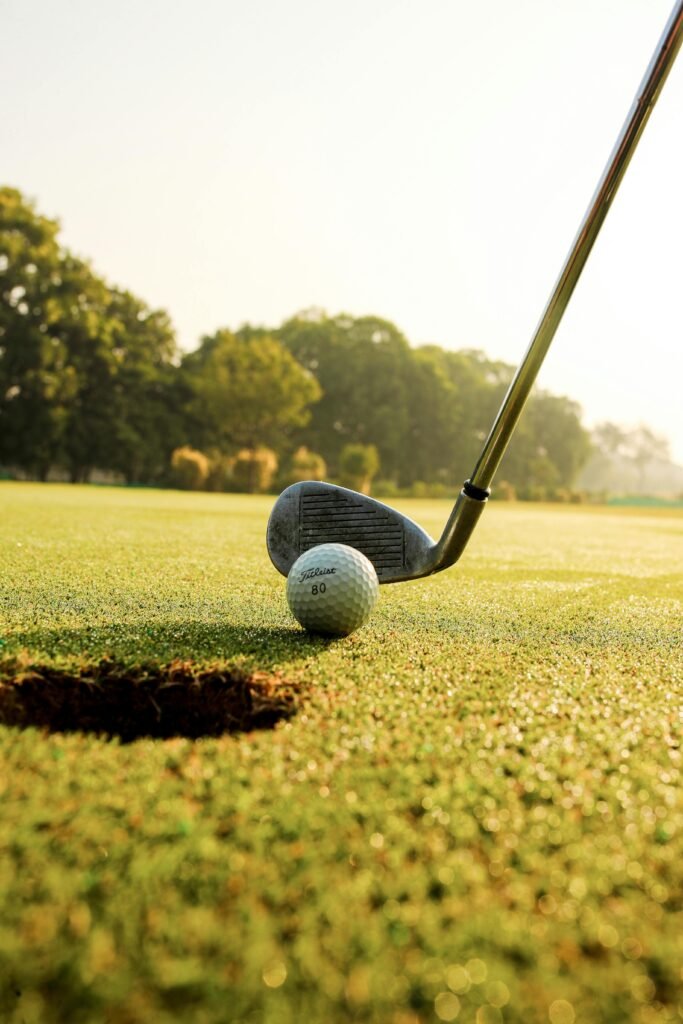
You’ve decided to try your hand at the ever-popular sport of golf, but you’re feeling a bit overwhelmed by the intricacies of the game. Fear not! This article aims to provide you with a concise and friendly introduction to the basic rules of golf, giving you the confidence you need to step foot onto the course and embark on this enjoyable journey. So grab your clubs and let’s dive into the fundamentals of this beloved sport!
Etiquette and Conduct
Respect for other players and the course
When playing golf, it is important to show respect both to the fellow players and the golf course itself. Treat others on the course with courtesy and be mindful of their concentration and focus. Avoid making unnecessary noise or distractions that could disrupt their shots. Additionally, taking care of the golf course is crucial. It is essential to repair divots, rake bunkers, and avoid causing damage to the course. By showing respect to others and the course, you contribute to a pleasant and enjoyable golfing experience for everyone involved.
Keeping up the pace of play
A fundamental aspect of golf etiquette is maintaining the pace of play. Golf is a game that relies on rhythm, and it is important to consider the time it takes to complete a round. Keep up with the group in front of you, and if you fall behind, allow faster players to play through. Be prepared for your shots, and limit the time spent searching for lost balls. By keeping the pace of play, you not only enhance the overall experience for everyone but also show consideration for others on the course.
Maintaining proper dress code
In order to maintain a professional and respectful atmosphere on the golf course, adhering to the proper dress code is essential. While dress codes may differ from course to course, there are some general guidelines to follow. Collared shirts and golf pants or shorts are usually required for men, while women are encouraged to wear appropriate golf attire such as golf tops, skirts, or pants. Avoid wearing denim, t-shirts, or athletic shorts, as they are typically not permitted. By dressing appropriately, you contribute to the overall ambiance and respect the traditions of the game.
Equipment and Golf Ball
Choosing the right golf clubs
Selecting the right golf clubs is crucial for playing your best game. Each club has unique characteristics and is designed for specific shots and distances. It is important to determine the suitable club for each situation based on factors such as distance, lie, and conditions. Understanding your personal ability and swing strengths will also play a role in club selection. Consult with professionals or experienced golfers to assist in finding clubs that suit your playing style and skill level. Using the right golf clubs will greatly contribute to improving your performance on the course.
Using conforming golf balls
When participating in any official golf event or competition, it is necessary to use conforming golf balls that meet the regulations set by golf governing bodies. Conforming golf balls have specific construction and performance standards to ensure fair play. These regulations typically include limitations on initial velocity, overall distance, and other ball characteristics. Always check the labeling and specifications of the golf balls you choose to ensure they conform to the standards set by the governing bodies.
Limitations on the number of clubs in a bag
Golfers are restricted by the rules of golf to carry a maximum of 14 clubs in their bag during a round. This limitation is in place to prevent players from gaining an unfair advantage by having an excessive number of specialized clubs. It is essential to consider the selection of clubs that cover a range of distances and shot types while staying within the 14-club limit. By carefully choosing the clubs in your bag, you can ensure that you are prepared for any situation on the course without exceeding the allowed number.
Proper care and use of golf equipment
Taking proper care of your golf equipment not only helps to extend its lifespan but also ensures optimal performance. Clean your clubs and golf balls after each round to remove dirt, grass, and debris. Inspect your clubs regularly for any signs of damage or wear and make any necessary repairs or replacements. It is also important to store your equipment in a suitable bag or case to protect it from damage. By maintaining your equipment, you can maximize its longevity and ensure consistent play.

Starting and Playing a Hole
Teeing off
When starting a hole, the tee shot sets the stage for the rest of the game. Be mindful of tee markers and their respective colors, which indicate the designated tee area. Tee the ball up within the markers and play it from there. During the tee shot, it is important to avoid hitting other players or interfering with their shots. Maintain focus and allow adequate time for fellow players to tee off before proceeding. By starting the hole with a proper teeing off procedure, you establish a good rhythm and set the tone for the remainder of the round.
Obstructions and hazards
During the course of a round, you may encounter various obstructions or hazards that can affect your play. These can include trees, bushes, water hazards, and sand bunkers, among others. When faced with an obstruction or hazard, it is important to understand the rules and options available to you. Depending on the situation, you may be allowed relief or required to play the ball as it lies. Familiarize yourself with the specific rules pertaining to different obstructions and hazards to make informed decisions and avoid unnecessary penalties.
Lost balls
It is not uncommon to hit an errant shot that results in a lost ball. When this happens, there are rules and procedures to follow. Start by searching for the ball within the acceptable time frame, typically five minutes. If the ball is not found within this time, add a penalty stroke and play a new ball from where the previous shot was played. While losing a ball can be frustrating, it is important to accept the outcome and continue playing in accordance with the rules.
Unplayable lies
Occasionally, your ball may come to rest in a position that makes it difficult or impossible to play. In such situations, you have the option to declare the ball unplayable. This allows you to take relief and play the ball from a different location on the course, subject to certain penalties. There are three relief options available for unplayable lies: stroke and distance, dropping within two club lengths, or dropping behind the point where the ball lay in line with the hole. Choose the option that offers the best chance of recovering from the difficult position.
Order of play
Maintaining a proper order of play is essential to avoid confusion and ensure fair play. The player with the lowest score on the previous hole typically tees off first on the following hole. Once the tee shots have been played, the player whose ball is furthest from the hole has the next shot. Continue this pattern until all players have completed the hole. It is important to pay attention to the order of play and not disrupt the flow by taking unnecessary shots out of turn. By following the designated order, the game progresses smoothly and efficiently.
Entering and Exiting Bunkers
Raking the bunker
When entering bunkers, it is important to be mindful of the impact your shot has on the sand. After playing a shot from a bunker, it is standard golf etiquette to rake the sand to leave it in a suitable condition for the next player. Use the provided rake to smooth out footprints, club marks, and any other disturbances made during the shot. Raking the bunker ensures fair play and maintains the sand’s consistency for future shots. Always make an effort to leave the bunker in better condition than you found it.
Various scenarios in bunkers
Being able to handle different scenarios in bunkers can greatly improve your overall game. When faced with a bunker shot, it is important to consider the distance to the green, the lie of the ball, and the height of the bunker’s lip. Adjust your stance and grip accordingly to execute the shot successfully. Understand the various types of bunker shots, such as green-side explosion shots, uphill or downhill bunker shots, plugged lies, or fairway bunker shots, and practice different techniques to become proficient in each situation. By mastering bunker play, you will have more confidence when faced with these challenging shots.
Putting and Scoring
Holding the putter
Properly holding the putter is essential for achieving consistent and accurate putting strokes. The most common grip used in putting is the reverse overlap grip, where the left hand is placed below the right hand (for right-handed golfers). This grip promotes stability and control in the hands, wrists, and forearms, allowing for a smoother stroke. Experiment with different grips and find the one that feels most comfortable and natural for you. Practice your putting stroke regularly to develop a consistent and repeatable motion.
Reading the greens
Reading the greens involves analyzing the slope, grain, and speed of the putting surface to make precise judgments on the necessary line and pace of the putt. Take your time to observe the contours and make note of any visible breaks or slopes on the green. Evaluate the overall speed of the greens by gauging the length of previous putts or paying attention to the ball’s roll during warm-up. Practice your ability to read greens by observing how putts break and green speeds on different courses. The more you practice and pay attention to the greens, the better you will become at reading them accurately.
Scoring in stroke play
In stroke play, each of your shots is counted throughout the round, with the total number of shots determining your score. The objective is to complete the round using the fewest number of shots possible. At the end of the round, add up the total number of strokes taken and record the score on the scorecard. The player with the lowest total score is the winner. Having a reliable scoring system and keeping an accurate record of your shots will allow you to track your progress and identify areas for improvement.
Scoring in match play
Match play is a format where each hole is a separate competition. The player who completes the hole with the fewest number of strokes wins that particular hole. The winner of the most holes at the end of the round wins the match. Unlike stroke play, the total number of strokes does not matter in match play. If a hole is tied, it is considered halved, and no points are awarded. Tracking your score in match play involves keeping track of the number of holes won, lost, and halved. Familiarize yourself with the scoring system to strategize effectively in match play.
Out of Bounds and Lost Ball
Relief options
If your ball is hit out of bounds or cannot be found within the allowed time, there are specific relief options available. Out-of-bounds areas are identified by white stakes or other markings. When a ball is hit out of bounds, you must replay the shot from the original spot, adding a one-stroke penalty. If your ball is lost, you also have the option to return to the spot where the last shot was played and play a new ball, again adding a penalty stroke. Understanding the relief options for out-of-bounds shots and lost balls will help you make informed decisions and avoid unnecessary penalties.
Strokes and penalties
When faced with various scenarios, it is important to be aware of the strokes and penalties associated with the rules of golf. Adding penalties for rule violations ensures fair play and maintains the integrity of the game. Penalty strokes can be incurred for actions such as hitting a ball out of bounds, hitting into water hazards, taking an unplayable lie, or other rule infractions. Understanding the strokes and penalties for different situations will help you make the best decision when faced with challenging circumstances and avoid unnecessary scorecard penalties.

Water Hazards and Lateral Water Hazards
Options for playing from water hazards
Water hazards pose a challenge for golfers, both mentally and strategically. When your ball lands in a water hazard, you have several options for proceeding. You can play the ball as it lies, although this carries the risk of hitting the ball into the hazard again. Alternatively, you can take stroke and distance relief by replaying the shot from the original position. Another option is to take lateral relief, where you drop a ball within two club lengths of where the ball crossed the hazard line, adding a penalty stroke. Assess the situation carefully to choose the most appropriate option based on the risk involved.
Penalties for playing from water hazards
Playing from a water hazard incurs certain penalties depending on the rules of golf. If you choose to play the ball from the water hazard, there is no additional penalty, but you run the risk of hitting the ball back into the hazard or facing a difficult shot. However, if you opt for penalty relief and take stroke and distance or lateral relief, you must add a penalty stroke to your score. Understanding the penalties associated with water hazards will help you make informed decisions and minimize scoring penalties.
Penalties and Free Relief
Various penalties for rule violations
Golf rules are designed to create a fair and equitable playing field. When a rule violation occurs, penalties are imposed to maintain the integrity of the game. Penalties can range from one to multiple strokes, depending on the severity of the violation. Rule violations can include hitting the ball out of bounds, grounding the club in a hazard, improving the lie without permission, or infringing on other players’ rights. It is crucial to understand the different penalties associated with rule violations to avoid unnecessary strokes and maintain the spirit of fair play.
Procedures for taking free relief
In certain situations, golfers are allowed free relief without incurring a penalty stroke. Free relief is provided to ensure fairness and protect players from certain circumstances on the course. Examples of situations where free relief may be granted include when a ball becomes embedded on a closely mown area through no fault of the player or when a player’s stance or swing is affected by a movable obstruction or abnormal ground condition. Familiarize yourself with the specific rules and procedures for taking free relief to make correct and informed choices when facing such circumstances.

Flagstick and Holed Balls
Leaving the flagstick in or out
Prior to a rule change, it was mandatory to remove the flagstick when putting. However, under the current rules, golfers have the option to leave the flagstick in while putting. Leaving the flagstick in the hole can help with alignment and provide a visual aid for gauging distance. Each golfer should decide whether leaving the flagstick in or removing it best suits their preferences and playing style. Experiment with both approaches during practice rounds to determine which method works best for your game.
Defining a ball as holed
To count a stroke as complete, the ball must be “holed.” A ball is considered holed when it comes to rest within the circumference of the hole and is not hanging or supported by the flagstick. It is important to be aware of how the ball behaves when it comes into contact with the flagstick while putting. If the ball strikes the flagstick and ends up in the hole, it is deemed holed. However, if the ball strikes the flagstick and remains outside the hole, it is not considered holed until it is subsequently struck into the hole. Understanding the definition of a holed ball will help prevent any confusion during play and ensure accurate scoring.
Interference and Interactions
Relief due to interference from immovable objects
When an immovable object, such as a building, cart path, or irrigation system, interferes with your stance, swing, or intended line of play, you are entitled to relief under the rules of golf. Interference occurs when these objects are physically close to the ball and have the potential to affect the outcome of the shot. To claim relief, identify the nearest point of complete relief, which is the closest position where the interference no longer affects your intended shot. Measure one club length from that point and drop a ball within the determined area to continue play without penalty.
Order of play when playing in a group
Playing in a group requires adhering to a specific order of play to ensure a smooth and efficient game. Typically, the player with the honors, earned by having the lowest score on the preceding hole, tees off first. After the tee shots, the player whose ball is furthest from the hole plays their shot. Continue this pattern throughout the round, always waiting for the player furthest from the hole to play before proceeding. Maintaining order of play in a group setting avoids confusion, minimizes delays, and promotes fairness among players.
